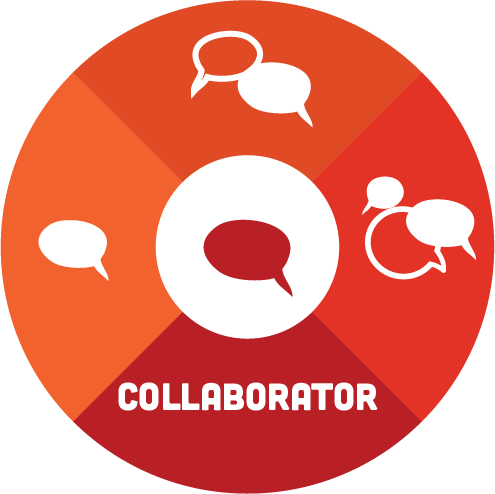

 In This Section
In This Section
We’ll have a look at the following topics:
- Finding your voice (raising your confidence)
- Curbing imposter syndrome (boosting self-esteem)
- Planning ahead (conflict/discomfort)
And work towards meeting these outcomes:
- Practicing and applying methods to raise confidence and voice your opinions
- Recognizing imposter syndrome and practical, effective ways to boost self-esteem
- Planning and preparing for uncomfortable situations
 Finding Your Voice
Finding Your Voice
If you experience fear of speaking up and sharing your ideas in various group settings, know you’re not alone. Many of us experience anxiety at the thought how how people might react to the things we say, especially in contexts with strangers or colleagues. “Is what I’m saying wrong?”, “Will I sound stupid?”, “What if I stutter?” These types of concerns are common and valid, but giving into them is doing yourself, and everyone around, a disservice. So, if you’re someone who can relate to these feelings, like in the Wicked Problems “Hi-5? More like Hi-Shy” or in “Lone Walker”, next are some tips to overcome these fears.
Be Kinder to Yourself
We’re all our own greatest critics. It’s important to give yourself the same compassion you would give others. So, don’t be too hard on yourself – it’s incredibly unlikely that anyone else is analyzing the things you say or do in the same way you analyze yourself. Show yourself some grace, and take the time to express your assets to yourself every now and then (Reach Out, n.d.)[1]. Talk yourself up and show yourself the love you deserve – it might sound silly, but we all need reminders of why we’re great, especially from ourselves. Don’t forget to celebrate all of your successes, the big and the small.
Make Mistakes
 If your fear surrounding speaking up is related to your fear of making mistakes, then the solution, which is easier said than done, is to embrace your mistakes. Making mistakes is a natural and expected part of life; it’s the way in which we do some of our best learning. And so, as scary as it sounds, rather than being so afraid of making a mistake, it’s important to instead embrace the fact that mistakes are going to happen.
If your fear surrounding speaking up is related to your fear of making mistakes, then the solution, which is easier said than done, is to embrace your mistakes. Making mistakes is a natural and expected part of life; it’s the way in which we do some of our best learning. And so, as scary as it sounds, rather than being so afraid of making a mistake, it’s important to instead embrace the fact that mistakes are going to happen.
Consider what happens when you do make a mistake – even when picturing the worst case scenario – think: 1) how likely is it for this to happen? and 2) is it really that bad? Know that, as long as you’re coming in with good intentions and aren’t hurting anyone, people won’t linger on the mistakes you might make in the same way that you might. On the contrary, people might not even register the mistakes you catch yourself making or will quickly move on and forget about it. And more importantly, we need to shift our focus onto the things that are in our control, such as sharing our thoughts, and less on the things we can’t control (Reach Out, n.d.).
Take chances – you can start small
You might not be ready to dive in completely to taking chances, so here are some steps you can take to work your way up. If you still experience fear sharing your thoughts, maybe start by asking questions instead. As Garfinkle (2021)[2] puts it: “Leverage your knowledge and expertise to probe deeper into what others are saying. You will feel more engaged and become an active participant, which will help facilitate a more powerful meeting and provide opportunities for others to truly see you.” Other suggestions include picking a topic ahead of time that you would like to discuss in your class, group meeting or work meeting – that way you’ll come prepared to participate in the discussion (Garfinkle, 2021). You can also challenge yourself by setting a goal of how many times you’d like to speak in a specific setting and/or by allowing yourself to say the first thing that pops into your head. As you start to do these things (you might be forcing yourself to at first) you’ll eventually build the habit of jumping into conversations without the overriding or lingering fears – it might even become second nature!
 Imposter Syndrome: A Wicked Problem by Sevda Montakhaby Nodeh
Imposter Syndrome: A Wicked Problem by Sevda Montakhaby Nodeh
A story about how imposter syndrome can take the joy out of life.
The Wicked Problem
“Anyone could do it” | “I don’t deserve to be here” | “It’s really not that hard”
“I’m not good enough” | “Anybody could get in” | “I don’t deserve this”
“It could’ve been anyone” | “You’re a fraud” | “I’m a fraud”
When I first came to Canada in grade 7, my English vocabulary consisted of “Hi” and “Ok”. I thought to myself, I am never going to learn an entire language, I’m done for. A year later I was reading the Hunger Games aloud in class to my peers during English, and I thought to myself, “that was easy, anyone could do it”. In grade 10, I was transferred to regular English classes, and out of ESL (English as Second Language) classes ahead of all of my friends who had immigrated to Canada earlier or around the same time as me. When I entered the grade 10 English class, everyone was a native speaker, and I thought to myself, “I don’t deserve to be here”. After receiving great grades all through high school I thought to myself, “it’s not really that hard”.
In high school suddenly marks mattered, and the university I had my heart set on required an average higher than 90%. I used to religiously check my home’s mailbox, anxiously waiting for a response from McMaster. one moment thinking “oh yeah, I will get in”, and the next thinking, there is “who do you think you are? There is no way. I’m not good enough”. On the day when I finally received my acceptance letter from McMaster, I didn’t scream in excitement, or celebrate in any special way. I just thought: “anybody could get in”.
The point is: I think that a task is near impossible, hard, and a great achievement reserved for only the best of the best, until I do it. Then I dismiss it as east. I could do it, anyone could.
Imposter syndrome takes the joy out of life. You put in the hard work. You go through the ups and downs. You suffer through all the stress and anxiety. All to amount to a little voice in your head saying, “you’re a fraud”. If you’re also suffering from this toxic mindset, I want you to know that you are not alone.
Finding a Solution
There is no one solution fix all. Curbing imposter syndrome is a life-long battle. Some battles you may lose, but the goal here is to win the war. The first step in the right direction is acknowledging imposter syndrome. Don’t run away from your negative feelings, instead start dancing in the rain ruining your parade.
As the negative feelings wash through you, the most important distinction I want you to make is one between humility and fear. There is a such thing as taking humility in your work and accomplishments, which is a good thing, an excellent thing in fact. But then, on the opposite side is the darker, deeper end of the pool, and as you venture out towards it, you will start to lose your footing, and before you know it, you’re stranded. This sinking feeling, that’s imposter syndrome. You must not give into your fears or try to justify them by riding them off as humility. That’s not coping with imposter syndrome, that’s dismissing it completely.
Kindness is your lifeguard. At the heart of it, imposter syndrome is about feeling unworthy. When you feel unworthy, then any achievement or good thing happening in your life may feel like luck. To escape this feeling of unworthiness, you must be kind to yourself. Bask in the glow of your achievements. Imposter syndrome isn’t loud, it’s a voice residing inside you, bringing you down within the privacy of your own mind.
It’s good to hold yourself up to a high standard, but you’re crossing a line when you’re beating yourself down. Kindness and forgiveness go together like peanut butter and jelly. Be kind to yourself and treat yourself the way you would like others to treat you.
Relinquish a bit of control, I promise you the world won’t end. Let others take the lead sometime, use their strengths, enjoy their input. I hate to break it to ya, but people are kind of amazing. Beautiful things come out of collaboration, such as this little module you’re reading right now.
Final Thoughts
One parting thought is: it always helps to talk to someone. Imposter syndrome is a lonely place to be because you constantly feel like a fraud, and a fraudster’s worst fear is being found out. However, speaking to someone, either a professional, mentor, a friend, or a family member can go a long way. Sharing your thoughts and experiences is part of the human experience, and it can be quite liberating. Vocalizing your negative thoughts, feelings, and issues by walking someone else through them can help you feel better equipped to deal with your imposter syndrome.
Planning ahead (for conflict and discomfort)
What is an uncomfortable or conflicting situation?
What defines an uncomfortable or conflicting situation varies from person to person. However, an uncomfortable or conflicting situation can occur when individuals are unwilling to compromise or have different opinions and perceptions. Some examples of uncomfortable situations for students include a peer taking credit for another person’s idea, receiving a rude email from a peer, reporting negative feedback about a peer, dealing with a peer that micromanages, or confronting a peer about how they mistreat others.
Why is it important to learn how to manage uncomfortable/conflicting situations?
If uncomfortable situations such as conflicts and disagreements aren’t managed, it could lead to a strained relationship between peers and foster a negative environment. The resulting discomfort and tension may hinder your ability to complete tasks successfully, impact your reputation, and create unnecessary stress for yourself. Thus, by learning how to manage uncomfortable situations at school, it’ll create a happier and more motivating environment, as well as dissipate the associated stress.
How to Manage an Uncomfortable Situation: Prepare, Plan and Act
- Identify the issue and purpose of the conversation: Before approaching the situation, it’s important to figure out what the issue is and what the outcome of the conversation will be. Some examples of clear outcomes include problem-solving together or learning the other persons perspective. However, if your only purpose is to vent or your upset feelings are unjustified then a conversation likely isn’t necessary.
- Make a plan: Planning out what to say and rehearsing it beforehand can help you keep the conservation focused on the issue at hand. When explaining your perspective, ensure to use respectful language and a polite tone to effectively get your point across without offending the other person. It’s also important to not dominate the conversation and listen to the other persons perspective. Being a good listener means to give the speaker your undivided attention by facing the speaker and holding eye contact.
- Invite the person to the conversation: When inviting the other person to the conversation, make sure your purpose is clear. It’s best to schedule a conversation so that the other person has time to plan. For instance, you can say “hey, I felt a bit uncomfortable with the conversation during the group meeting so I’m wondering if we can schedule a time to talk about it? I’d like to understand your perspective and for you to understand mine as well.” This demonstrates that you’re genuinely interested in listening to their perspective and sharing your perspective in order to come to a conclusion.
- Determine the best method of communication: Some individuals may feel more comfortable communicating using text, email, calling, video chat, or an in-person meeting depending on their preference.
- Have the conversation: Ideally, the issue will be resolved by the end of the conversation. However, sometimes the differences in perspectives are too extensive. In these cases, try to find commonalities, such as maintaining a positive environment at school, and sustaining professional interactions going forward, despite the differences. In situations where to other persons behaviour is adversely impacting you in ways that you cannot look past (e.g., they are continuing to use harmful language or acting unethically), then it’s important to bring up the situation to a superior, such as a professor at school.[3][4][5]
 Activity: False stereotypes
Activity: False stereotypes
Purpose of Activity
The purpose of this activity is to develop an understanding of why we shouldn’t pass brash judgments onto others. The activity is meant for us to consider why we receive certain judgments, and consider how we can respond to the judgments passed on us.
Task:
Think of the different ways in which you feel you have been perceived by others. Did you ever feel you have been pigeonholed or stereotyped as a result of a trait you possess, an experience you had, a habit you have, your working process, or other reasons? For instance, some of us may have been called high strung for caring too much about how our work should be completed, and some of us may have been stereotyped as lazy for dropping the ball in a group project. Consider the ways in which you might have been stereotyped, then consider what you wish people knew or understood about you in regard to that stereotype. In thinking about the ways you have been misunderstood and how it made you feel, consider the times you may have passed judgement onto someone else, and whether there could have been more to the story from that person’s perspective.
Learning Outcomes
- Plan and prepare for uncomfortable academic and school situations.
- Practice and apply methods to boost your confidence and voice your opinions
Level 1
Consider the ways you feel you have been stereotyped in the past. What judgments have been passed on to you and why? How did they make you feel? Was there anything you could or should have done differently? (Approximately 5 – 10 minutes).
Level 2
Now that you’ve reflected on the ways you’ve been stereotyped, think of the things you wish people knew or understood about you. How could others knowing these things about you help? Consider times you have passed judgement onto others and how those feelings would have influenced how you interacted with them. (Approximately 5 – 10 minutes).
Level 3
Share your reflections with someone, whether it be a family member, friend, or colleague. Reflect on how the conversation goes; see if taught you anything (Approximately 5 – 10 minutes).
Time Commitment
This activity should take approximately 15 – 30 minutes to complete.
Success Criteria
- Honest and genuine reflection.
- Develop an understanding of how others respond to us.
- Prepare ways of communicating the things we wish people understood about us.
- Develop practices to understanding and empathizing with others.
What do I do with this?
If you are playing along using the Liberated Learner Work Binder, upload your “False Stereotypes” file to the Collaborator Module folder.
If this is the only Liberated Learner activity you plan to do, then save the file wherever you like. Don’t forget to share it with your friends and family to wow them with your insightful reflections.
Wrap Up and Look Ahead
In this section we’ve tried to set you up to advocate for yourself in collaborative experiences. Next we will take it a step further, and examine how you might also advocate for others as an effective ally.
- Reach Out.com. (n.d.). 10 tips for improving your self-esteem. Reach Out.Com. https://au.reachout.com/articles/10-tips-for-improving-your-self-esteem ↵
- Garfinkle, A., J. (2021). 10 ways to increase visibility in meetings. Garfinkle Executive Coaching. https://garfinkleexecutivecoaching.com/articles/stand-out-and-get-noticed/10-ways-to-increase-visibility-in-meetings ↵
- https://kpu.pressbooks.pub/hrcommunication/chapter/managing-uncomfortable-situations/ ↵
- https://www.psychologytoday.com/us/blog/people-planet-profits/202008/how-prepare-difficult-conversation ↵
- https://www.judyringer.com/resources/articles/we-have-to-talk-a-stepbystep-checklist-for-difficult-conversations.php ↵


